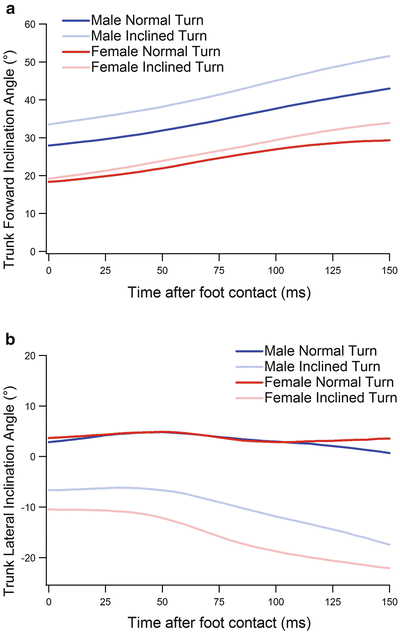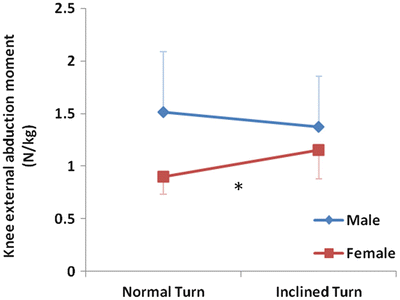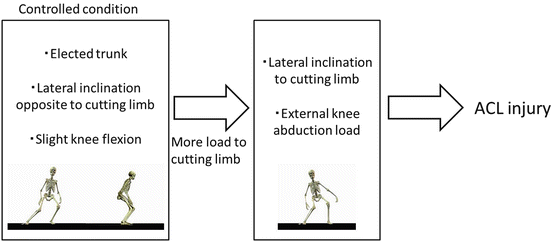Fig. 11.1
Gender differences in posture during shuttle run cutting; (a) male and (b) female. Female athletes show a smaller knee flexion angle, smaller forward trunk angles, and greater lateral trunk angles with the inclination opposite to the cutting limb
11.4 Gender Differences in the Capacity of Cutting Kinematics
Gender differences are seen in athletic performance in relation to both reaction and change.. A previous study (Nagano et al. 2011a), noted that an increase in the forward inclination of the trunk may decrease the risk of ACL injury. We examined the gender differences in lower limb kinematics and kinetics when athletes were instructed to perform the shuttle run cutting maneuver with a forward inclination of the trunk (Nagano et al. 2011b). In response to this instruction, female athletes demonstrated an increase in knee and hip flexion angle (Fig. 11.2), a decrease in hip internal rotation angle (Fig. 11.2), and an increase in hip internal extension moment (Nagano et al. 2011b) (Fig. 11.4). On the other hand, female athletes demonstrated an increase in lateral inclination of the trunk toward the cutting limb (Fig. 11.3) instead of a forward inclination of the trunk, and also a tendency to increase the knee external abduction moment (Nagano et al. 2011b) (Fig. 11.5). These results suggested that the instruction to increase forward inclination of the trunk alone disturbed the female athlete’s trunk control and increased the knee load, thereby increasing the risk of ACL injury.





Fig. 11.2
Angular displacement of knee and hip with and without instruction to increase forward inclination of the trunk. Data are presented for (a) knee flexion/extension, (b) knee abduction/adduction, (c) external/internal tibial rotation, (d) hip flexion/extension, (e) knee abduction/adduction, and (f) hip external/internal rotation

Fig. 11.3
Angular displacement of forward and lateral inclination of the trunk with and without instruction to increase forward inclination of the trunk. Data are presented for (a) trunk forward inclination and (b) trunk lateral inclination

Fig. 11.4
Joint internal moments of knee and hip with and without instruction to increase forward inclination of the trunk. Data are presented for (a) knee flexion/extension, (b) knee abduction/adduction, (c) external/internal tibial rotation, (d) hip flexion/extension, (e) knee abduction/adduction, and (f) hip external/internal rotation

Fig. 11.5
Change in the knee external abduction moment with and without instruction to increase forward inclination of the trunk. As a result of instruction to increase forward inclination of the trunk, there was a significant interaction effect (*: p <0.05). Female athletes showed a greater tendency to increase the knee external abduction moment
A detailed knowledge of gender differences for trunk and knee kinematics and kinetics allowed us to better understand the strategy adopted by female athletes during the cutting maneuver. In a controlled experimental environment, female athletes perform the cutting maneuver with an erect trunk, laterally inclined opposite to the cutting limb, and the knee in slight flexion to avoid an increase in external knee abduction load. This position requires low muscle support, and is similar to the Trendelenburg sign in which the limb is supported by the iliotibial tract. When instruction or other disturbing forces increase the load on the cutting limb, female athletes are unable to control the need to depend on the trunk. This leads to lateral inclination of the trunk toward the cutting limb, and an increase in the knee external abduction moment. This response may be caused by insufficient trunk or muscle activity; moreover, it may also be the mechanism by which ACL injury is caused (Fig. 11.6). To decrease the risk of ACL injury, we should screen the trunk position during the cutting task and improve hip and trunk muscle activity of female athletes to encourage forward inclination of the trunk.


Fig. 11.6
Schematic representation of the strategy adopted by female athletes during the cutting maneuver
11.5 Conclusion
The purpose of this paper is to utilize recent research advances to clarify gender differences in the strategy adopted by athletes during the cutting maneuver. Experimental tasks that detect the risk of ACL injury should involve the use of trunk control, such as shuttle run cutting; trunk control should be included in the overall analysis. A greater understanding of the gender differences in trunk and knee kinematics and kinetics, as well as the reaction to instruction will allow us to better understand the strategy of female athletes during the cutting maneuver. To decrease the risk of ACL injury, trunk position during the cutting task should be screened for forward and lateral inclination, and improved hip and trunk muscle activity employed to encourage forward inclination of the trunk.
Stay updated, free articles. Join our Telegram channel

Full access? Get Clinical Tree








